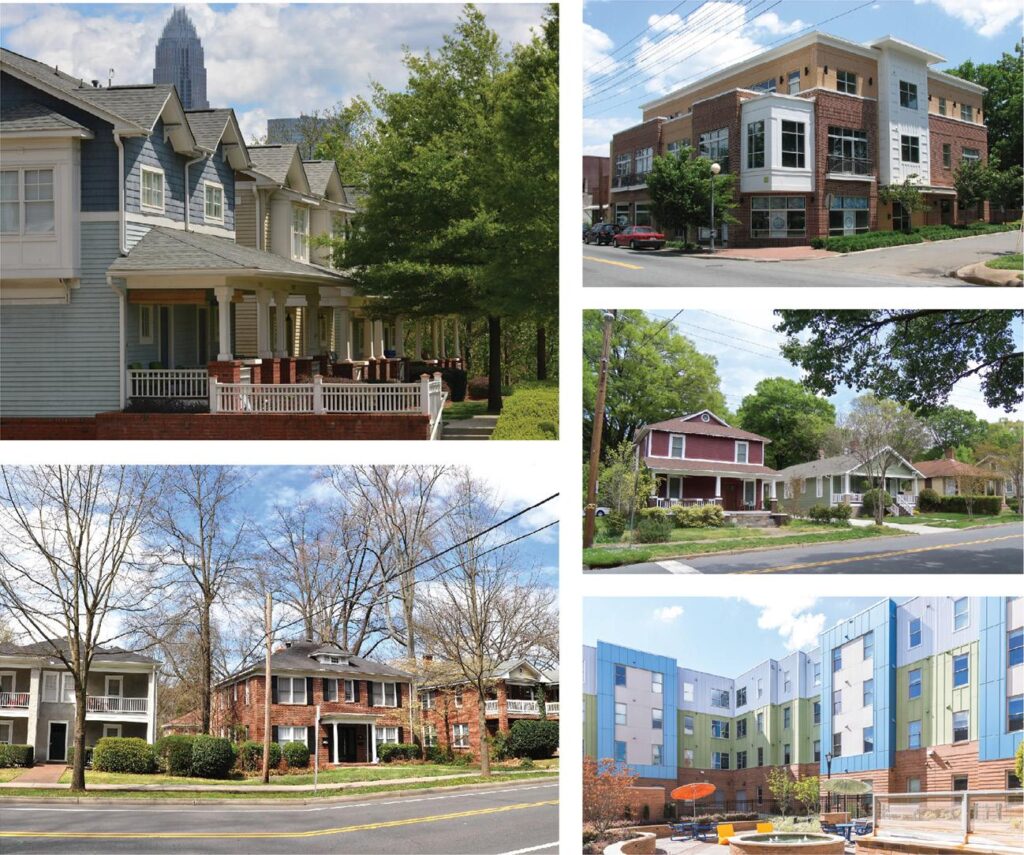Home / 03. Policy Framework / Goal 2: Neighborhood Diversity and Inclusion
Plan Policy
Table of contents
Goal 2: Neighborhood Diversity and Inclusion

Goal 2: Neighborhood Diversity and Inclusion

Charlotte will strive for all neighborhoods to have a diversity of housing options by increasing the presence of middle density housing (e.g. duplexes, triplexes, fourplexes, townhomes, accessory dwelling units (ADUs), and other small lot housing types) and ensuring land use regulations allow for flexibility in creation of housing within neighborhoods.

Objectives
- Increase the score of the overall Access to Housing Opportunity equity metrics index for the City.
- Increase the number of Accessory Dwelling Units (ADUs) in existing and new neighborhoods.
- Increase the number of middle density units such as duplexes and triplexes in all neighborhoods.
- Increase the number of middle density housing options, including fourplexes, along high performance transit and other major thoroughfares.
- Increase the number of middle density housing options in transition areas between low intensity neighborhoods and higher intensity Place Types.
- Increase the number of residential dwelling units with less than one parking space per unit.
- Increase the number of small footprint housing units in existing and new neighborhoods.
Big Policy Ideas
- Allow more housing types in traditional single-family zoning districts to encourage housing diversity everywhere in our community.
Policies
- Overcome exclusionary zoning practices that further housing segregation and displacement, exacerbate sprawl, and make housing unaffordable. Allow single-family, duplex, and triplex housing units, as well as small footprint homes and accessory dwelling units (ADUs), in neighborhood Place Types and corresponding zoning districts where single-family housing is allowed. Mapping of neighborhood Place Types will respond to and incorporate the Equitable Growth Framework. Site development standards will be specified within the Unified Development Ordinance (UDO) such as residential lot size, setbacks, scale, height, parking, and other dimensional standards. Note: Implementation of this in vulnerable communities (as defined by this Comprehensive Plan) will be complemented with development of an Anti-Displacement Strategy with greater community participation in developing specific strategies to meet housing needs and protect vulnerable residents from displacement. New zoning and entitlements included in the UDO would not change any codes, covenants and restrictions (CC&Rs) associated with HOAs.
- Allow fourplexes on all lots fronting arterials where single-family detached dwellings are permitted when key city priorities are advanced and benefits to the public are provided such as affordable and/or workforce housing.
- Provide opportunities for single-family attached and small-scale multifamily housing developments (15 units or less) near transit services and along arterials in lower density, predominantly residential areas (applies to Neighborhood 1).
- In the development regulations, allow single-family attached housing, fourplexes and small-scale multifamily housing along major thoroughfares in lower density, predominantly residential areas (applies to Neighborhood 1).
- In the development regulations, support the development of ADUs within a greater number of existing neighborhoods with changes to setback requirements and other site development standards.
- In the development regulations, reduce barriers to development of new high quality middle density housing units such as reducing the need to rezone, reduced application fees, expedited processing, density bonuses, reduced or eliminated parking requirements, and reduced or waived inspection fees.
- Work toward reducing or removing barriers identified in the Accessory Dwelling Unit Report and the Charlotte Housing Framework report regarding missing middle housing and evaluate development regulations, such as required lot sizes, clustered home development, neighborhood character overlay districts, and other tools to reduce barriers.
- Ensure that housing access incentives provide adequate infrastructure and minimize impact on environmental quality and tree canopy.
- In the development regulations, require larger developments to include a mix of housing types.
- In the development regulations, assess and reduce barriers to innovative housing solutions such as tiny homes, modular housing, and co-housing, as well as innovative construction and delivery methods such as prefabrication, 3D printing, and other emerging technologies.
- Preserve existing supply of middle density and small footprint housing and reduce conversion to large-footprint single-family units using a neighborhood character overlay district.
- Use small area planning efforts to determine additional strategies to integrate more diverse housing options that support each community’s unique character.
- Allow parking to be unbundled from lease of property or include as part of development agreements, especially in areas with a parking management strategy.
- Request an amendment to the State Landlord and Tenant Act to add Post Judgment Relief agreement. This will allow residents to have evictions removed from their records upon payment-in-full of outstanding debt/judgment.
- Request legislation to amend state landlord-tenant and fair housing laws to end housing discrimination for persons with misdemeanors and some felony criminal records.
- Ensure that landlords, particularly of affordable housing units, maintain a habitable premises as part of the State Landlord and Tenant Act.
Recommended Projects And Programs
- Continue to reduce parking for transit supportive development, pocket neighborhoods, cottage clusters, and development in Activity Centers to reduce the cost of development and encourage development of more mixed housing types in areas with a parking management strategy.
- Adopt changes to development regulations to allow for more housing options/types and additional ADUs within existing neighborhoods, and adopt flexible requirements for minimum housing mix in new master planned developments.
- Develop new design form management standards for middle density housing in the development regulations or develop an overlay conservation district that supports the intent of the Equitable Growth Framework.
- Work with the development community to determine the most important tools and barriers related to delivery of middle density housing.
- Provide education and guidance for the development of innovative housing solutions such as tiny homes, modular housing, co-housing, and prefabricated homes.
- Create a funding program to assist low-income homeowners with construction of ADUs in return for a commitment to rent the unit at an affordable price, for a designated period of time (i.e., in exchange for a deed restriction associated with the ADU), especially in areas with existing or planned access to employment, amenities, goods, and services. This serves the dual purpose of increasing affordable housing stock and increasing homeowner income.
- The Mayor and City Council should commission an Anti-Displacement Stakeholder Group/Commission.
- The Group/Commission will launch an anti-displacement study and recommend tools and strategies for protecting residents of moderate to high vulnerability of displacement. Using Commission recommendations, Council may adopt an Anti-Displacement Strategy focusing on vulnerable neighborhoods.
- Continue and establish programs to provide support for inclusion of affordable housing units when single-family units are removed, particularly in neighborhoods vulnerable to displacement.

Image source: https://medium.com/@pdx4all/cottage-clusters-portlands-chance-to-build-community-in-a-new-way-7c504c5b260b
Several communities in the Pacific Northwest are enabling and encouraging cottage clusters as a way to address missing middle housing opportunity. Cottage clusters generally involve taking a relatively large tract of land (e.g. 10,000 square feet), which would ordinarily accommodate a few single-family homes, and instead zone and develop it for several small buildings, adding up to the same size (e.g. six 1,080-square-foot homes). The cottage zoning includes requirements that cottages face a common yard and/or have design elements like deep porches. Residents typically share parking and other community facilities. This idea of housing type can provide a reasonably-priced housing option while also promoting sustainable living, especially located near transit, bikeways, and other walkable amenities.

Image source: 1) https://www.coldwellbankerhomes.com/mn/minneapolis/2537-grand-ave-s/pid_32786669/ 2) https://www.edinarealty.com/multi-family-for-sale/2522-madison-street-ne-minneapolis-mn-55418-5608998
Minneapolis, Minnesota is a leader in changing neighborhood housing options for the future. Its Minneapolis 2040 Comprehensive Plan established policy paving the way for eliminating exclusionary single-family zoning policies citywide, which in the past has kept most people of color and practically all low-income people from single-family zoned neighborhoods. Affecting nearly 425,000 residents, Minneapolis originally set aside 70% of its residential land for single-family homes. Allowing duplexes and triplexes in all of these areas triples the housing capacity in many neighborhoods and significantly reduces the City’s need to extend utilities and services to support greenfield development. The change is intended to: make the Minneapolis more affordable and walkable; combat climate change by reducing commutes; and reduce racial and economic segregation. Proponents also say that it can help create attainable housing for millennials and young families, and help seniors age in place with the potential for extra income.
In 2017, the City of Austin, Texas created a task for by resolution to address gentrification and displacement in the rapidly growing city. The Task Force, made up of 17 members appointed by the Mayor and City Council, conducted a ten-month process that resulted in a set of detailed policy recommendations and funding mechanisms. The group also worked in conjunction with faculty at the University of Texas. Key outcomes from their final report included recommendations for increasing funding through tax increment financing; developer fees tied to density bonuses; lobbying state legislature to allow inclusionary zoning; Right to Remain and Right to Return policies; limiting property taxes for seniors; Tenant Opportunity to Purchase policies; a Troubled Building Initiative (as seen in Chicago); and strongly enforcing fair housing laws and examining vestiges of housing discrimination.
